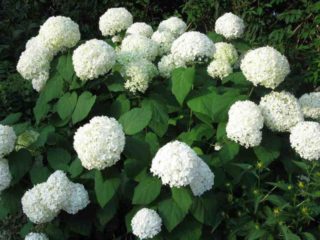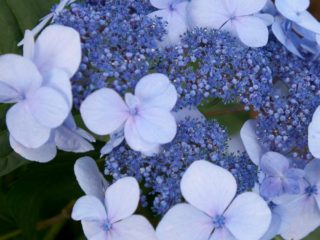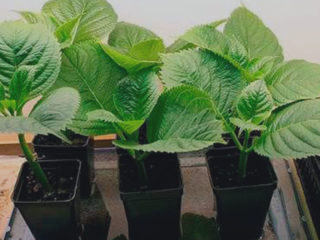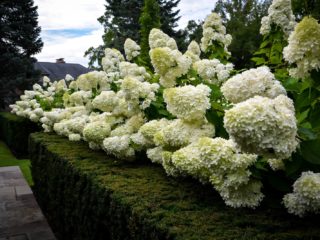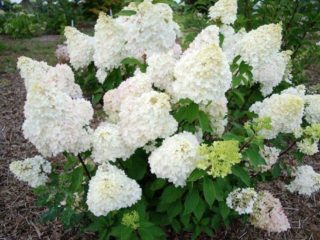Content
- 1 Do I need to prune paniculata hydrangea in spring?
- 2 Why do you need to prune hydrangea paniculata in spring?
- 3 When can you prune paniculata hydrangea in spring?
- 4 How to prune paniculata hydrangea correctly in spring
- 5 Caring for paniculata hydrangea after spring pruning
- 6 Advice from experienced gardeners
- 7 Conclusion
In many garden plots you can find paniculata hydrangea - a beautiful perennial shrub with lush caps of flowers. In order to preserve its decorative properties longer, the plant is periodically pruned, removing some of the shoots from the crown. Pruning paniculate hydrangea in the spring not only promotes abundant flowering, but also rejuvenates the plant, significantly prolonging its life.
Do I need to prune paniculata hydrangea in spring?
Hydrangea paniculata is distinguished not only by the rapid growth of shoots, but also by increased shoot formation. Over time, this leads to a strong thickening of the bush, it takes on a sloppy appearance, and the number of flowers on it decreases. The appearance of the inflorescences also deteriorates; they become sparse and faded. Old shoots inhibit the growth of young ones. In addition, thickening of the bush is a risk factor for the appearance of diseases and pests on hydrangeas.
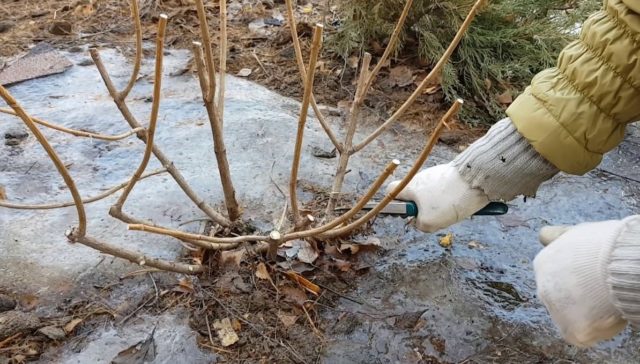
Pruning in spring is necessary for lush flowering of paniculate hydrangea.
Spring pruning of paniculate hydrangea has a number of advantages over carrying out this procedure in the autumn. Here are some of the positive points:
- Spring pruning of paniculata hydrangea promotes rapid restoration of the bush after the winter period.
- This procedure rids the hydrangea of weak, frozen, dried and broken branches, which can become a source of disease or a breeding ground for insect pests.
- Stimulates the growth of young shoots on which flower caps will form.
- When pruning in the spring, the likelihood of freezing of the pruned shoots is reduced.
- In spring it is easier to determine which shoots need to be removed.
Spring pruning improves the appearance and decorativeness of the bush, reduces the likelihood of diseases, and prolongs the life of the plant. With all its positive qualities, it also has disadvantages:
- Short period for work.
- Pruning significantly delays the start of flowering.
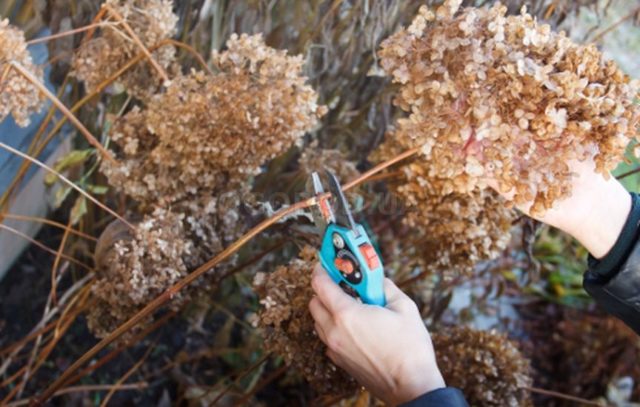
Dried hydrangea paniculata inflorescences cannot be left until spring
Why do you need to prune hydrangea paniculata in spring?
There are several types of pruning that are used for paniculate hydrangea:
- Sanitary. This procedure is used to remove broken and dried branches and shoots that have frozen over the winter. Sanitary pruning means any actions related to cleaning the bush, reducing the likelihood of outbreaks of infections and pests on it.In addition to spring, this procedure must be carried out in the fall, and in emergency cases it can be done in the summer.Important! In case of severe mechanical damage or damage to the bush, sanitary pruning should be radical; shoots are removed to stumps 40-50 cm long. The bush will not bloom next year, but such an extreme measure helps save the plant from death.
- Rejuvenating. Carry out to stimulate the growth of new shoots. During this procedure, old branches on which flowering no longer occurs are removed to the base. After rejuvenating pruning, the bush should contain about 10 young strong shoots.
- Formative. This type of pruning is required for a young panicle hydrangea bush to ensure that the bush grows evenly and has the correct shape.
- Standardizing or regulating. This is done to give the bush fullness, as well as to regulate the number of flower stalks.
Different types of pruning are usually combined depending on the age of the bush, since they are carried out at once and at the same time.
When can you prune paniculata hydrangea in spring?
Hydrangea paniculata can be grown in different climatic zones, so the timing of the beginning of its growing season can vary significantly. Therefore, when pruning, you need to focus not on the calendar date, but on weather conditions. Paniculate hydrangeas need to be pruned at the very beginning of the growing season, when the plant is just beginning to wake up. In this case, the ambient temperature should not fall below 0 °C, otherwise the cut shoots will freeze.
You shouldn’t delay too much when starting pruning either.If you are late and prune the bush after the growing season has begun, then recovery will take a long time, the plant will be sick and will begin to flower much later.
How to prune paniculata hydrangea correctly in spring
To prune paniculate hydrangea, it is most convenient to use ordinary garden pruners. The cutting edges of the tool must first be cleaned and disinfected, otherwise there is a risk of infection. The secateurs should be sharp, so it will leave clean, even cuts without fringe, which will quickly close. Otherwise, the cut edges will get wet for a long time and will not heal soon.
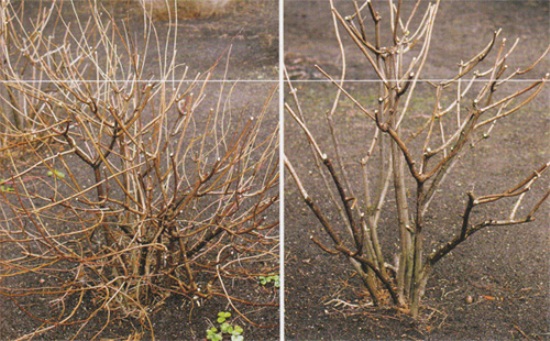
This is what a paniculate hydrangea bush looks like before and after pruning.
The scheme for pruning paniculate hydrangea in spring is quite simple, its main stages are:
- Carry out sanitary cleaning of the bush. All shoots that were damaged or broken in winter are cut off at the root. The same should be done with small branches and shoots older than 4 years, since they do not form flower stalks, but only thicken the bush.
- The second stage is to trim the side shoots at a height slightly higher than the 2nd pair of buds. This way, the growth of young lateral shoots is stimulated, which will give the bush volume and splendor.
- Thin out the crown, remove weak young shoots from the center of the bush, and cut off shoots growing inward.
An interesting video for beginners on how to properly prune paniculate hydrangea in spring:
Caring for paniculata hydrangea after spring pruning
To help paniculate hydrangea bushes recover as quickly as possible after spring pruning, it is imperative to provide it with sufficient moisture and nutrients. Watering at this time should be carried out regularly, making sure that the root zone of the plant does not dry out. At the same time, there is no need to flood the bush; excess water is harmful for hydrangeas. The root zone should be mulched with litter or the bark of coniferous trees; this will not only retain moisture in the soil, preventing it from evaporating, but will also additionally acidify the soil.
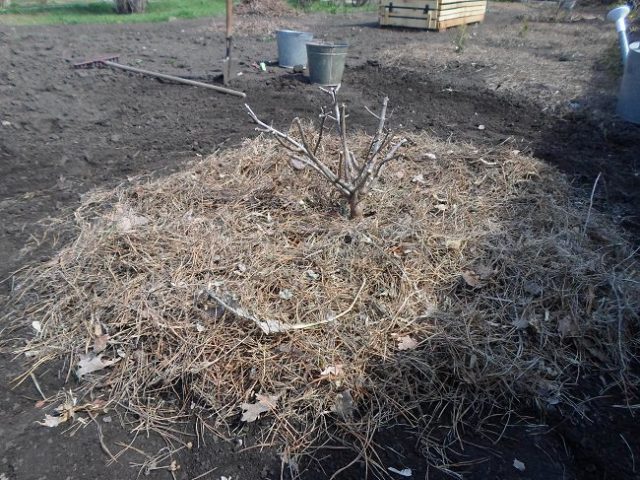
Mulching the soil with fallen pine needles retains moisture and maintains acidity
After pruning, the plants must be fed. In early spring, they especially need nitrogen fertilizers; the lack of this element inhibits the growth of shoots, reduces the foliage of the bush and its decorativeness. To feed paniculate hydrangeas, it is recommended at this time to use a solution of urea and potassium sulfate (2 tablespoons per bucket of water), which is used to evenly irrigate the root zone. For 1 bush, 0.5 buckets of liquid fertilizer is enough. Instead of urea, you can use other nitrogen-containing fertilizers: nitroammophoska or azofoska, ammonium sulfate, ammonium nitrate.
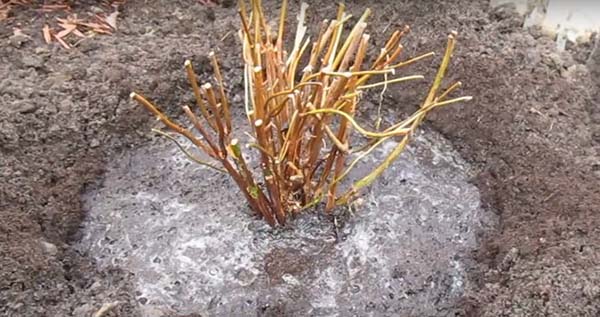
Fertilizers are applied to the soil only after preliminary watering
In early spring, paniculate hydrangeas can be fed not only with mineral fertilizers, but also with organic matter: a solution of slurry, infusion of mullein, chicken droppings.Some gardeners prefer to use slow-release fertilizers designed specifically for feeding hydrangeas, rhododendrons and azaleas. They are sold in specialized stores under the trademarks Fertika, Pokon, Green Wood, etc.

Special fertilizers for hydrangeas are an excellent alternative to conventional fertilizers.
Advice from experienced gardeners
When carrying out a procedure such as pruning, it is worth taking into account the experience of gardeners who have been growing these plants for a long time. This will help avoid mistakes and greatly simplify your work. Here are some tips to help you prune paniculate hydrangeas correctly in the spring:
- The colder the climate of the region in which paniculate hydrangea is grown, the more carefully you need to plan the date of the work. The threat of return frosts must be eliminated completely. It is better to wait a while and carry out the work later than to freeze already trimmed bushes.
- Hydrangea paniculata tolerates pruning well, so there is no need to be afraid that due to inexperience you can cut off something unnecessary. However, when carrying out this procedure for the first time, it is advisable to first study this issue in theory, and carry out the actual pruning under the guidance of an experienced gardener.
- Recognizing old shoots that will never bloom again is quite simple. They are darker brown in color, have a tree-like structure and multiple bark cracks. Such branches must be cut at the root.
- After pruning, be sure to clean the bush and remove all cut parts.The cleaner the inside of the shrub is, the better it will feel, the less likely it is to get sick or have pests appear on it.
- In paniculate hydrangeas, from 1 to 3 shoots can grow from each bud. To make the bush more lush and rounded, you should cut out the branches that grow inside the bush, leaving those that are directed outward.
Conclusion
Pruning paniculate hydrangea in the spring should be done every season. This is a good way to maintain the decorativeness of the bush at a high level, and at the same time rejuvenate it, thereby extending its life. Pruning paniculate hydrangea is not particularly difficult, and even a novice gardener can cope with it. You just need to understand the principle of this work and choose the right time.
